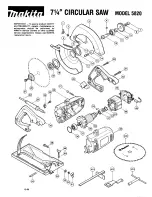
EN
29
• If the tool is used outdoors, only use an
extension cord approved for outdoor use.
Cords intended for outdoor use reduce the
risk of electric shock.
• If it is absolutely necessary to use power
tools in damp conditions, use a power
point protected by a residual current
device. Using an RCD reduces the risk of
electric shock.
PERSONAL SAFETY
• Stay alert at all times. Follow all the
relevant safety instructions, and use your
common sense when working with power
tools. Never use power tools if you are
tired or under the influence of drugs,
alcohol or medication. A moment of
inattention when using a power tool can
result in serious personal injury.
• Use safety equipment. Always wear safety
glasses.
• Depending on the type of power tool and
how it is used, safety equipment such as
dust masks, non-slip safety shoes, safety
helmets and ear protection reduce the risk
of personal injury.
• Avoid accidental starting. Check that the
power switch is switched off before
plugging in the power cord. Carrying a
power tool with your finger on the switch,
or connecting a tool to the mains supply
when the switch is in the ON position,
increases the risk of accidents and injuries.
• Always check that Allan keys/spanners etc.
have been removed from the tool before
switching it on. Allen keys, or the like, left
in a rotating part of a power tool can
cause personal injury.
• Do not overreach. Always maintain a firm
footing and good balance. This will ensure
you have better control over the tool in
unexpected situations.
• Wear suitable clothing. Do not wear
loose-fitting clothing or jewellery. Keep
your hair, clothing and gloves away from
moving parts. Loose-fitting clothing,
SAFETY INSTRUCTIONS
WARNING!
Read all warnings, safety instructions and
other instructions carefully before use. Failure
to follow all the instructions and safety
instructions can result in the risk of electric
shock, fire and/or serious personal injury.
WORK AREA
• Keep the work area clean and well lit.
Dark and cluttered work areas increase
the risk of accidents and injuries.
• Do not use power tools in explosive
environments, such as in the vicinity of
flammable liquids, gas or dust. Power
tools produce sparks that can ignite dust
and fumes.
• Keep children and onlookers at a safe
distance when using the power tool.
You can easily lose control of the
equipment if you are distracted.
ELECTRICAL SAFETY
• The plug on the power tool must match
the power point. Never modify the plug in
any way. Never use an adapter with
earthed power tools. Unmodified plugs
and matching power points reduce the
risk of electric shock.
• Avoid body contact with earthed surfaces
such as pipes, radiators, cookers and
refrigerators. There is an increased risk of
electric shock if your body is earthed.
• Do not expose power tools to rain or
moisture. There is an increased risk of
electric shock if water gets into a power tool.
• Be careful with the power cord. Never
carry or pull the tool with the power cord,
or pull the cord to pull out the plug. Keep
the power cord away from heat, oil, sharp
edges and moving parts. Damaged or
tangled power cords increase the risk of
electric shock.
















































